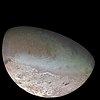Triton is the largest moon of the planet Neptune, discovered on October 10, 1846, by William Lassell. It is the only large moon in the Solar System with a retrograde orbit, which is an orbit in the opposite direction to its planet's rotation. At 2,700 km (1,700 mi) in diameter, it is the seventh-largest moon in the Solar System. Because of its retrograde orbit and composition similar to Pluto's, Triton is thought to have been captured from the Kuiper belt. Triton consists of a crust of frozen nitrogen over an icy mantle believed to cover a substantial core of rock and metal. The core makes up two-thirds of its total mass. Triton has a mean density of 2.061 g/cm3 (1.191 oz/cu in) and is composed of approximately 15–35% water ice. Triton is one of the few moons in the Solar System known to be geologically active. As a consequence, its surface is relatively young, with a complex geological history revealed in intricate and mysterious cryovolcanic and tectonic terrains. Part of its crust is dotted with geysers believed to erupt nitrogen.
